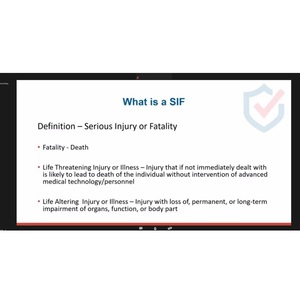PMSS: Near miss reporting for SIF reduction

December 17, 2020
BY Lisa Gibson
Documenting, communicating and resolving near misses can help reduce incidents that cause serious injury or death. Jacob Hencke, with PROtect, emphasized this in his presentation during the Plant Maintenance and Safety Summit, Dec. 16 and 17.
Hencke presented during the panel “Your Most Valuable Asset: Deploying Safety Strategies Aimed at Eliminating Lost Time Injuries, Near Misses.”
“Your most valuable asset: your people,” he said.
Not all incidents have the same risk level, so they can’t all be evaluated through the same lens, Hencke said. A fall from an elevated platform is a serious injury or fatality (SIF) incident, whereas a fall on slippery ice on the ground is a non-SIF incident.
A SIF includes fatality, life-threatening injury or illness, and life-altering injury or illness. Life-threatening injuries are those that are likely to lead to death without immediate medical attention. Life-altering injuries could include injury that causes permanent or long-term impairment of organs, function, or a body part. Hencke cited burns as an example of a life-altering injury.
Advertisement
Hencke shared a story about employees raking coal in a powerhouse. Employees knew that if too much coal piled up, it would release a fireball while raking. They told each other informally about this risk, but it was not reported or documented as a near miss. “Employees didn’t recognize this hazard, that it had serious injury potential and it should be dealt with.”
SIF precursors like this can go unnoticed because they’re identified in near misses or missed entirely due to lack of reporting, recognition or knowledge about the reporting process. But SIF precursors can be eliminated before they have a chance to occur, Hencke said.
Hencke implored managers to think critically about SIF near misses. “Do your employees readily identify near misses, or does your site simply not have near misses?” Do employees have near miss training? Do managers support near miss reporting? If one is reported, is it addressed in a positive manner to encourage further near miss reporting?
“Near misses are a critical part of not just regular safety, but specifically incidents that have serious injury, fatality potential,” Hencke said.
SIF incidents could include mobile equipment operation, energy isolation, elevated work, suspended load, line break/chemical exposures, confined space, and contractor activities. But not all carry the same SIF potential, Hencke said. In a recent evaluation, PROtect found that 80 percent of mobile equipment operation had SIF potential, while confined space work was at 100 percent SIF potential.
“You have to take a multipronged approach,” he said.
Advertisement
Robust near miss reporting would include incident investigation protocol with SIF precursor identification; and review for site-specific operations (hazardous operations, etc.).
Not all incidents are SIF, he cautioned, so reducing SIFs doesn’t necessarily reduce all hazardous incidents. But, of course, they’re the most dangerous and developing a protocol will help protect a plant’s most valuable assets.
Related Stories
SAF Magazine and the Commercial Aviation Alternative Fuels Initiative announced the preliminary agenda for the North American SAF Conference and Expo, being held Sept. 22-24 at the Minneapolis Convention Center in Minneapolis, Minnesota.
Saipem has been awarded an EPC contract by Enilive for the expansion of the company’s biorefinery in Porto Marghera, near Venice. The project will boost total nameplate capacity and enable the production of SAF.
Global digital shipbuilder Incat Crowther announced on June 11 the company has been commissioned by Los Angeles operator Catalina Express to design a new low-emission, renewable diesel-powered passenger ferry.
International Air Transport Association has announced the release of the Sustainable Aviation Fuel (SAF) Matchmaker platform, to facilitate SAF procurement between airlines and SAF producers by matching requests for SAF supply with offers.
Alfanar on June 20 officially opened its new office in London, further reaffirming its continued investment in the U.K. The company is developing Lighthouse Green Fuels, a U.K.-based SAF project that is expected to be complete in 2029.
Upcoming Events










